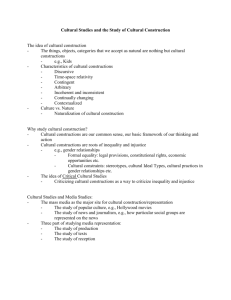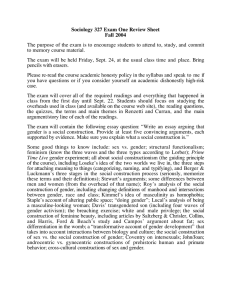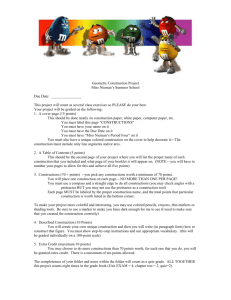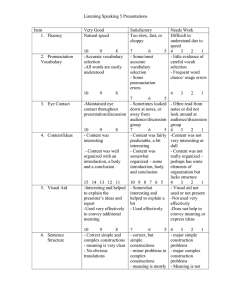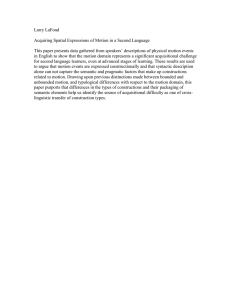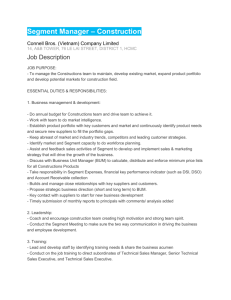Symposium: Constructions
advertisement
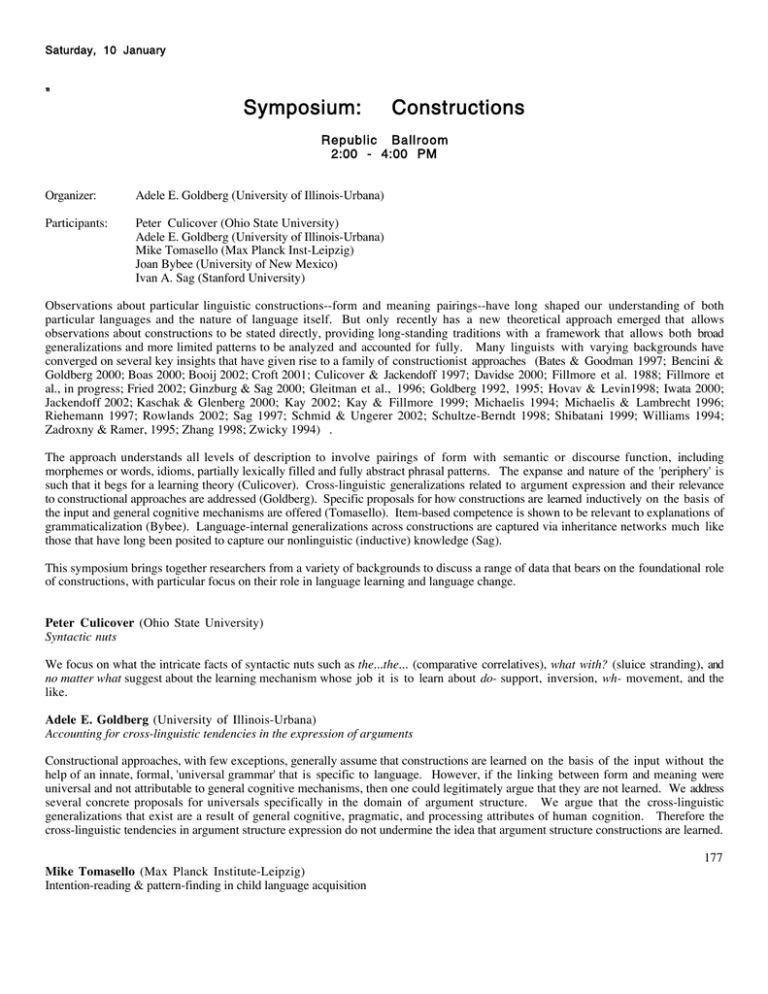
Saturday, 10 January " Symposium: Constructions Republic Ballroom 2:00 - 4:00 PM Organizer: Adele E. Goldberg (University of Illinois-Urbana) Participants: Peter Culicover (Ohio State University) Adele E. Goldberg (University of Illinois-Urbana) Mike Tomasello (Max Planck Inst-Leipzig) Joan Bybee (University of New Mexico) Ivan A. Sag (Stanford University) Observations about particular linguistic constructions--form and meaning pairings--have long shaped our understanding of both particular languages and the nature of language itself. But only recently has a new theoretical approach emerged that allows observations about constructions to be stated directly, providing long-standing traditions with a framework that allows both broad generalizations and more limited patterns to be analyzed and accounted for fully. Many linguists with varying backgrounds have converged on several key insights that have given rise to a family of constructionist approaches (Bates & Goodman 1997; Bencini & Goldberg 2000; Boas 2000; Booij 2002; Croft 2001; Culicover & Jackendoff 1997; Davidse 2000; Fillmore et al. 1988; Fillmore et al., in progress; Fried 2002; Ginzburg & Sag 2000; Gleitman et al., 1996; Goldberg 1992, 1995; Hovav & Levin1998; Iwata 2000; Jackendoff 2002; Kaschak & Glenberg 2000; Kay 2002; Kay & Fillmore 1999; Michaelis 1994; Michaelis & Lambrecht 1996; Riehemann 1997; Rowlands 2002; Sag 1997; Schmid & Ungerer 2002; Schultze-Berndt 1998; Shibatani 1999; Williams 1994; Zadroxny & Ramer, 1995; Zhang 1998; Zwicky 1994) . The approach understands all levels of description to involve pairings of form with semantic or discourse function, including morphemes or words, idioms, partially lexically filled and fully abstract phrasal patterns. The expanse and nature of the 'periphery' is such that it begs for a learning theory (Culicover). Cross-linguistic generalizations related to argument expression and their relevance to constructional approaches are addressed (Goldberg). Specific proposals for how constructions are learned inductively on the basis of the input and general cognitive mechanisms are offered (Tomasello). Item-based competence is shown to be relevant to explanations of grammaticalization (Bybee). Language-internal generalizations across constructions are captured via inheritance networks much like those that have long been posited to capture our nonlinguistic (inductive) knowledge (Sag). This symposium brings together researchers from a variety of backgrounds to discuss a range of data that bears on the foundational role of constructions, with particular focus on their role in language learning and language change. Peter Culicover (Ohio State University) Syntactic nuts We focus on what the intricate facts of syntactic nuts such as the...the... (comparative correlatives), what with? (sluice stranding), and no matter what suggest about the learning mechanism whose job it is to learn about do- support, inversion, wh- movement, and the like. Adele E. Goldberg (University of Illinois-Urbana) Accounting for cross-linguistic tendencies in the expression of arguments Constructional approaches, with few exceptions, generally assume that constructions are learned on the basis of the input without the help of an innate, formal, 'universal grammar' that is specific to language. However, if the linking between form and meaning were universal and not attributable to general cognitive mechanisms, then one could legitimately argue that they are not learned. We address several concrete proposals for universals specifically in the domain of argument structure. We argue that the cross-linguistic generalizations that exist are a result of general cognitive, pragmatic, and processing attributes of human cognition. Therefore the cross-linguistic tendencies in argument structure expression do not undermine the idea that argument structure constructions are learned. 177 Mike Tomasello (Max Planck Institute-Leipzig) Intention-reading & pattern-finding in child language acquisition Most accounts of language acquisition use as analytic tools adult-like syntactic categories and schemas (grammars) with little concern for whether they are psychologically real for young children. Recent research has demonstrated, however, that children do not operate initially with such abstract linguistic entities but instead operate on the basis of concrete, item-based constructions. Children construct more abstract linguistic constructions only gradually by processes of analogy and distributional analysis, with type and token frequency playing key roles. They constrain their constructions to their conventional ranges of use--gradually as well--again on the basis of linguistic experience in which type and token frequency play key roles (entrenchment, preemption). Reading the communicative intentions of the language user is a necessary component in all of these acquisition processes. Joan Bybee (University of New Mexico) Construction grammar & two types of morphosyntactic change Construction grammar, especially when paired with an exemplar-based representational system, offers a particularly effective model for the description of morphosyntactic change. We examine two patterns of change. First, in grammaticization, a particular instance of a construction (such as be going to as a particular instance of a general movement verb + infinitive of purpose) increases in frequency, becomes autonomous, and gradually begins to change in meaning and form. Thus in grammaticization a new construction develops out of an old construction. A construction grammar provides a means of describing both the source and the outcome of grammaticization. If exemplars are also represented, the probabilistic changes in use of the construction can be represented as gradually affecting cognitive representations. In the second pattern of change, a new construction gradually replaces an older one, as when English not- negation on the first element of the auxiliary replaces negation that follows the verb, e.g. I don't know anything about it is gradually replacing I know nothing about it. Tottie 1991 shows that high frequency verbs such as be, have, do, say, and know tend to retain the older construction just as high frequency irregular verbs tend to resist change towards the more productive patterns. As in the case of irregular verbs, which can be said to have stronger lexical representations because of high frequency, we can say that high frequency instances of constructions have stronger representation in an exemplar model and maintain more conservative patterns for this reason. Ivan A. Sag (Stanford University) Construction families: An analytic challenge for generative grammar The type-based approach to constructional analysis has the advantage that it allows cross-constructional generalizations of varying grain to be expressed naturally. For example, Fillmore 1999 (also Newmeyer 1998) points out that English has various kinds of 'inverted' clauses, including the exclamatives in 1a, the 'blesses, wishes and curses' in 1b, the conditionals in 1c, and polar interrogatives like 1d: (1) a. Boy, [was I stupid]! b. May your teeth fall out on your wedding night! c. [Were they here now], we wouldn't have this problem. d. Were they involved? The dozen or so aux- inversion constructions have an obvious 'family resemblance' (including common lexical exceptions) but differ in terms of constructional meaning, main/embedded clause, etc. Similarly, extraction constructions all consist of a 'dislocated' filler phrase and a clause containing one or more gaps, but they differ with respect to meaning, inversion (2a), main/embedded clause (2b), the presence of a particular kind of wh- word within the filler (2c), the category of the filler (2d, 2e), permitting infinitives (2f), and so forth: (2) a. [[What a nice person] Kim is/*is Kim!] (no inversion w. exclamative) b. [[How tall] is Kim/*Kim is?] (oblig. inversion w. matrix interrogative) c. The question of/*book [[what] they like] remains mysterious. (int. vs relative with what) d. [[To how many people] has he written?/*he has written!] (int. vs. excl. with PP filler) e. the question of/*people [[who(m)] to confer with]}... (inf. int. vs. inf. rel. with NP filler) f. *Bagels, to like. (no infinitival topicalization) Natural languages abound with construction families exhibiting clear common properties, general but defeasible constraints of varying grain, and construction-specific exceptions. Generative grammar has failed to provide precise analyses of generalizations, subregularities, and constructional idiosyncrasy. However, by drawing on established techniques within computer science and knowledge representation (e.g. inheritance hierarchies, default logics), construction grammar is able to provide detailed, precise, and extensible analyses of both the general and the exceptional properties of grammatical constructions. 178
